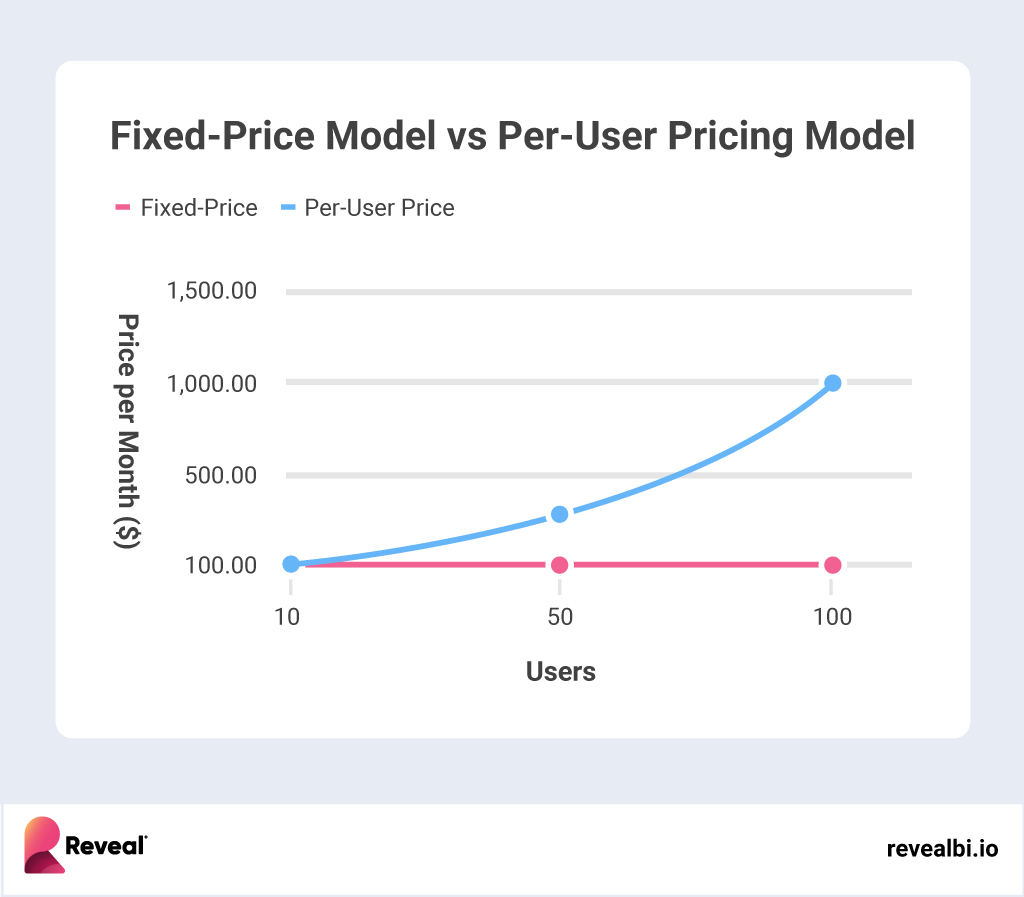
Scriptly Helps Pharmacies Identify Trends in Real Time with Reveal

As more organizations embed analytics into their business applications, one question stands out: “What is the ROI of embedded analytics?”
In this whitepaper, we explore the topic of ROI in embedded analytics in detail, covering cost considerations, the pros and cons of different pricing models, metrics for measuring ROI, and more. You will also understand the importance of choosing the right embedded analytics vendor and how the vendor’s licensing model can influence your return on investment.
Fill out the form to continue reading.
Embedded analytics is a strategic approach for directly integrating analytics capabilities into existing business applications and software solutions, facilitating real-time data access within users’ natural workflow. By embedding analytics into their core business applications and systems, organizations can leverage countless benefits, including quicker time to market, increased customer satisfaction, and enhanced decision-making.
Some of the main benefits of embedded analytics for businesses considering investment are its potential to accelerate time to market, enhance competitiveness, and drive revenue generation.
For example, hotels can integrate analytics into their reservation systems to analyze booking patterns, forecast demand, and optimize room pricing strategies. By leveraging embedded analytics, hotels can maximize occupancy rates, increase revenue per available room (RevPAR), and maintain a competitive edge in the hospitality industry.
Without embedded analytics, organizations encounter numerous challenges that hinder their growth and competitiveness.
The primary hurdle, however, lies in the substantial investment of resources and capital needed to develop in-house analytics solutions. From infrastructure setup to talent acquisition and ongoing maintenance costs, the financial burden can be overwhelming and unsustainable for many businesses.
Fortunately, embedded analytics tools offer a compelling solution to these challenges, bridging the gap between data and actionable insights while providing a cost-effective alternative to internal development. By leveraging established embedded analytics platforms, organizations can tap into pre-built analytics functionalities without the heavy upfront investment. This not only reduces financial strain but also accelerates time-to-market, empowers faster decision-making, and enhances overall operational efficiency.
Moreover, the advantages of embedded analytics extend beyond cost savings. Organizations gain a competitive edge by delivering more value to customers, driving increased user satisfaction, and fostering innovation. The ability to customize analytics solutions to specific business needs ensures tailored experiences that resonate with users and deliver meaningful outcomes.
According to the Reveal Annual Survey Report, which highlights a growing trend in embedded analytics adoption, with 73.2% of respondents already incorporating embedded analytics and 71.6% planning to do so, it’s clear that embedded analytics are no longer a luxury but a strategic imperative.
Return on Investment (ROI) is a financial ratio metric used to evaluate an investment’s profitability. In the context of embedded analytics, an embedded analytics ROI is the tangible contribution of the solution to a business.
The ROI assessment of embedded analytics involves comparing the benefits against the cost of the solution (including both implementation and maintenance costs). Several factors can influence the tangible contribution of an embedded analytics solution, including cost savings, revenue growth, and increased productivity. Improved decision-making, enhanced customer satisfaction, and competitive advantage also play crucial roles in measuring the ROI of embedded analytics.
There are a variety of metrics you can choose from to measure ROI. These are the most popular and effective ways to do it:
Cost Savings: This method of measuring the ROI of embedded analytics involves quantifying the reduction in operational expenses attributable to embedded analytics implementation. Through embedded analytics, organizations can reduce (or completely eliminate) costs associated with data storage and costly on-premises hardware investments, for example.
Example Calculation:
Cost Savings = (Previous Year’s Operational Expenses) – (Current Year’s Operational Expenses with Embedded Analytics)

For instance, if an organization spent $500,000 on operational expenses in the previous year and reduces it to $400,000 with the implementation of embedded analytics, the Cost Savings would be $100,000.
Revenue Growth: Measuring the impact of embedded analytics on your company’s bottom line is one of the most obvious yet effective ways to evaluate ROI. This can include increasing revenue through marketing and sales optimization based on data insights, identifying new sales opportunities, or increasing up-and-cross-sell opportunities.
Example Calculation:
Revenue Growth = (Revenue with Embedded Analytics) – (Revenue without Embedded Analytics)

Consider a scenario where a company’s revenue increases from $1 million to $1.5 million after implementing embedded analytics. The Revenue Growth attributed to embedded analytics would be $500,000.
Analytics Usage: How and how often users are using the analytical capabilities and dashboards is another way to measure your ROI for embedded analytics. You will need to attribute a monetary value to each customer to measure analytics usage.
Example Calculation:
Analytics Usage ROI = (Monetary Value per Customer) x (Increase in Analytics Usage)

Suppose a company values each customer at $1000 and sees a 20% increase in analytics usage after deploying embedded analytics. The Analytics Usage ROI would be $200 per customer.
Customer Satisfaction: By using KPIs such as NPS (net promoter score) or CSAT (customer satisfaction score) with customer value, you can better attach a dollar value to each incremental point when measuring the ROI of embedded analytics.
Example Calculation:
Customer Satisfaction ROI = (Value of Each Incremental NPS or CSAT Point) x (Improvement in NPS or CSAT)

If each incremental NPS point is valued at $50 and the organization improves its NPS score by 10 points after implementing embedded analytics, the Customer Satisfaction ROI would be $500.
When looking for an embedded analytics vendor, cost is a major consideration for most organizations. Each model carries its own set of considerations, benefits, and potential pitfalls, making the decision a critical factor in the success and ROI of your analytics endeavors. Among these models, two prominent approaches stand out: the per-user pricing model and the fixed-price model, exemplified by Reveal’s approach. This chapter aims to shed light on these models, their implications, and why choosing the right pricing strategy is paramount for businesses of all sizes.
Understanding Embedded Analytics Pricing Models
Per-User Pricing Model:

Startup Scenario:
Per-User Pricing Model: $10 per user per month, starting with 10 users = $100 per month ($1200 per year).
In 2-3 years, with 100 users = $1000 per month ($12000 per year).
Fixed-Price Model (Reveal): Consistent cost over time, providing stability and peace of mind during business scaling.
Fixed-Price Model (Reveal’s Approach):
Considerations for Choosing the Right Pricing Model:

Choosing the right pricing model is crucial for maximizing ROI and ensuring cost-effectiveness in embedded analytics solutions. While per-user pricing may seem attractive initially, a fixed-price model like Reveal’s offers stability and financial predictability, making it a better investment in the long run, regardless of company size or user base.
Reveal is an industry-leading embedded analytics solution that provides self-service capabilities, white-labeling, and numerous features and functionalities for data analysis.
We invite you to learn more about Reveal and what else sets it apart by scheduling a demo or downloading our SDK for a free 30-day test trial.
You can also explore more by browsing our website and watching our guides and tutorials on our YouTube channel. If you have any questions, don’t hesitate to contact our product team, who can answer them all on our Discord channel.
Back to Top